
Mallard mother and ducklings, San Elijo Lagoon, Encinitas.
Location: San Elijo Lagoon, Encinitas, California
Image ID: 39345
Location: San Elijo Lagoon, Encinitas, California
Image ID: 39345

Pot-bellied seahorse, male, carrying eggs. The developing embryos are nourished by individual yolk sacs, and oxygen is supplied through a placenta-like attachment to the male. Two to six weeks after fertilization, the male gives birth. The babies must then fend for themselves, and few survive to adulthood.
Species: Pot-bellied seahorse, Hippocampus abdominalis
Image ID: 14472
Species: Pot-bellied seahorse, Hippocampus abdominalis
Image ID: 14472

Pot-bellied seahorse, male, carrying eggs. The developing embryos are nourished by individual yolk sacs, and oxygen is supplied through a placenta-like attachment to the male. Two to six weeks after fertilization, the male gives birth. The babies must then fend for themselves, and few survive to adulthood.
Species: Pot-bellied seahorse, Hippocampus abdominalis
Image ID: 14558
Species: Pot-bellied seahorse, Hippocampus abdominalis
Image ID: 14558

Mallard mother and ducklings, San Elijo Lagoon, Encinitas.
Location: San Elijo Lagoon, Encinitas, California
Image ID: 39343
Location: San Elijo Lagoon, Encinitas, California
Image ID: 39343

Mallard mother and ducklings, San Elijo Lagoon, Encinitas.
Location: San Elijo Lagoon, Encinitas, California
Image ID: 39344
Panorama dimensions: 5400 x 8640
Location: San Elijo Lagoon, Encinitas, California
Image ID: 39344
Panorama dimensions: 5400 x 8640

Pot-bellied seahorse, male, carrying eggs. The developing embryos are nourished by individual yolk sacs, and oxygen is supplied through a placenta-like attachment to the male. Two to six weeks after fertilization, the male gives birth. The babies must then fend for themselves, and few survive to adulthood.
Species: Pot-bellied seahorse, Hippocampus abdominalis
Image ID: 11027
Species: Pot-bellied seahorse, Hippocampus abdominalis
Image ID: 11027

Pot-bellied seahorse, male, carrying eggs. The developing embryos are nourished by individual yolk sacs, and oxygen is supplied through a placenta-like attachment to the male. Two to six weeks after fertilization, the male gives birth. The babies must then fend for themselves, and few survive to adulthood.
Species: Pot-bellied seahorse, Hippocampus abdominalis
Image ID: 11031
Species: Pot-bellied seahorse, Hippocampus abdominalis
Image ID: 11031
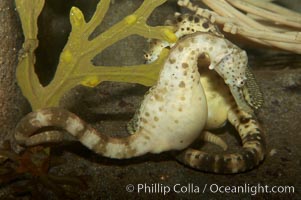
Pot-bellied seahorse, male, carrying eggs. The developing embryos are nourished by individual yolk sacs, and oxygen is supplied through a placenta-like attachment to the male. Two to six weeks after fertilization, the male gives birth. The babies must then fend for themselves, and few survive to adulthood.
Species: Pot-bellied seahorse, Hippocampus abdominalis
Image ID: 11032
Species: Pot-bellied seahorse, Hippocampus abdominalis
Image ID: 11032
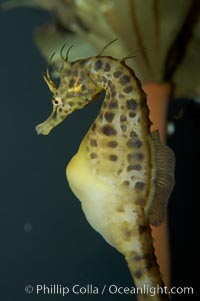
Pot-bellied seahorse, male, carrying eggs. The developing embryos are nourished by individual yolk sacs, and oxygen is supplied through a placenta-like attachment to the male. Two to six weeks after fertilization, the male gives birth. The babies must then fend for themselves, and few survive to adulthood.
Species: Pot-bellied seahorse, Hippocampus abdominalis
Image ID: 11897
Species: Pot-bellied seahorse, Hippocampus abdominalis
Image ID: 11897

Pot-bellied seahorse, male, carrying eggs. The developing embryos are nourished by individual yolk sacs, and oxygen is supplied through a placenta-like attachment to the male. Two to six weeks after fertilization, the male gives birth. The babies must then fend for themselves, and few survive to adulthood.
Species: Pot-bellied seahorse, Hippocampus abdominalis
Image ID: 11898
Species: Pot-bellied seahorse, Hippocampus abdominalis
Image ID: 11898
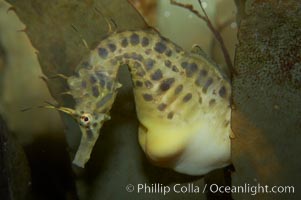
Pot-bellied seahorse, male, carrying eggs. The developing embryos are nourished by individual yolk sacs, and oxygen is supplied through a placenta-like attachment to the male. Two to six weeks after fertilization, the male gives birth. The babies must then fend for themselves, and few survive to adulthood.
Species: Pot-bellied seahorse, Hippocampus abdominalis
Image ID: 11900
Species: Pot-bellied seahorse, Hippocampus abdominalis
Image ID: 11900

Pot-bellied seahorse, male, carrying eggs. The developing embryos are nourished by individual yolk sacs, and oxygen is supplied through a placenta-like attachment to the male. Two to six weeks after fertilization, the male gives birth. The babies must then fend for themselves, and few survive to adulthood.
Species: Pot-bellied seahorse, Hippocampus abdominalis
Image ID: 11901
Species: Pot-bellied seahorse, Hippocampus abdominalis
Image ID: 11901

Pot-bellied seahorse, male, carrying eggs. The developing embryos are nourished by individual yolk sacs, and oxygen is supplied through a placenta-like attachment to the male. Two to six weeks after fertilization, the male gives birth. The babies must then fend for themselves, and few survive to adulthood.
Species: Pot-bellied seahorse, Hippocampus abdominalis
Image ID: 11902
Species: Pot-bellied seahorse, Hippocampus abdominalis
Image ID: 11902

Pot-bellied seahorse, male, carrying eggs. The developing embryos are nourished by individual yolk sacs, and oxygen is supplied through a placenta-like attachment to the male. Two to six weeks after fertilization, the male gives birth. The babies must then fend for themselves, and few survive to adulthood.
Species: Pot-bellied seahorse, Hippocampus abdominalis
Image ID: 11903
Species: Pot-bellied seahorse, Hippocampus abdominalis
Image ID: 11903

Pot-bellied seahorse, male, carrying eggs. The developing embryos are nourished by individual yolk sacs, and oxygen is supplied through a placenta-like attachment to the male. Two to six weeks after fertilization, the male gives birth. The babies must then fend for themselves, and few survive to adulthood.
Species: Pot-bellied seahorse, Hippocampus abdominalis
Image ID: 11904
Species: Pot-bellied seahorse, Hippocampus abdominalis
Image ID: 11904

Pot-bellied seahorse, male, carrying eggs. The developing embryos are nourished by individual yolk sacs, and oxygen is supplied through a placenta-like attachment to the male. Two to six weeks after fertilization, the male gives birth. The babies must then fend for themselves, and few survive to adulthood.
Species: Pot-bellied seahorse, Hippocampus abdominalis
Image ID: 14473
Species: Pot-bellied seahorse, Hippocampus abdominalis
Image ID: 14473

Pot-bellied seahorse, male, carrying eggs. The developing embryos are nourished by individual yolk sacs, and oxygen is supplied through a placenta-like attachment to the male. Two to six weeks after fertilization, the male gives birth. The babies must then fend for themselves, and few survive to adulthood.
Species: Pot-bellied seahorse, Hippocampus abdominalis
Image ID: 14474
Species: Pot-bellied seahorse, Hippocampus abdominalis
Image ID: 14474
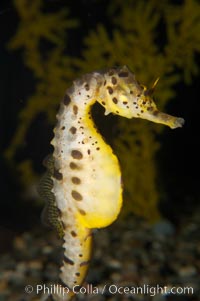
Pot-bellied seahorse, male, carrying eggs. The developing embryos are nourished by individual yolk sacs, and oxygen is supplied through a placenta-like attachment to the male. Two to six weeks after fertilization, the male gives birth. The babies must then fend for themselves, and few survive to adulthood.
Species: Pot-bellied seahorse, Hippocampus abdominalis
Image ID: 14475
Species: Pot-bellied seahorse, Hippocampus abdominalis
Image ID: 14475
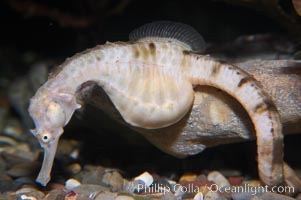
Pot-bellied seahorse, male, carrying eggs. The developing embryos are nourished by individual yolk sacs, and oxygen is supplied through a placenta-like attachment to the male. Two to six weeks after fertilization, the male gives birth. The babies must then fend for themselves, and few survive to adulthood.
Species: Pot-bellied seahorse, Hippocampus abdominalis
Image ID: 14476
Species: Pot-bellied seahorse, Hippocampus abdominalis
Image ID: 14476

Banggai Cardinalfish. Once thought to be found at Banggai Island near Sulawesi, Indonesia, it has recently been found at Lembeh Strait and elsewhere. The male incubates the egg mass in his mouth, then shelters a brood of 10-15 babies in his mouth after they hatch, the only fish known to exhibit this behaviour. Unfortunately, the aquarium trade is threatening the survival of this species in the wild.
Species: Banggai cardinalfish, Pterapogon kauderni
Image ID: 08900
Species: Banggai cardinalfish, Pterapogon kauderni
Image ID: 08900

Banggai Cardinalfish. Once thought to be found at Banggai Island near Sulawesi, Indonesia, it has recently been found at Lembeh Strait and elsewhere. The male incubates the egg mass in his mouth, then shelters a brood of 10-15 babies in his mouth after they hatch, the only fish known to exhibit this behaviour. Unfortunately, the aquarium trade is threatening the survival of this species in the wild.
Species: Banggai cardinalfish, Pterapogon kauderni
Image ID: 08901
Species: Banggai cardinalfish, Pterapogon kauderni
Image ID: 08901
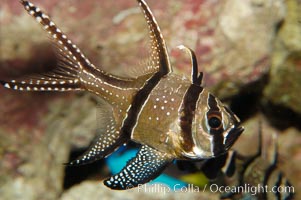
Banggai Cardinalfish. Once thought to be found at Banggai Island near Sulawesi, Indonesia, it has recently been found at Lembeh Strait and elsewhere. The male incubates the egg mass in his mouth, then shelters a brood of 10-15 babies in his mouth after they hatch, the only fish known to exhibit this behaviour. Unfortunately, the aquarium trade is threatening the survival of this species in the wild.
Species: Banggai cardinalfish, Pterapogon kauderni
Image ID: 08902
Species: Banggai cardinalfish, Pterapogon kauderni
Image ID: 08902

Banggai Cardinalfish. Once thought to be found at Banggai Island near Sulawesi, Indonesia, it has recently been found at Lembeh Strait and elsewhere. The male incubates the egg mass in his mouth, then shelters a brood of 10-15 babies in his mouth after they hatch, the only fish known to exhibit this behaviour. Unfortunately, the aquarium trade is threatening the survival of this species in the wild.
Species: Banggai cardinalfish, Pterapogon kauderni
Image ID: 09229
Species: Banggai cardinalfish, Pterapogon kauderni
Image ID: 09229

Banggai Cardinalfish. Once thought to be found at Banggai Island near Sulawesi, Indonesia, it has recently been found at Lembeh Strait and elsewhere. The male incubates the egg mass in his mouth, then shelters a brood of 10-15 babies in his mouth after they hatch, the only fish known to exhibit this behaviour. Unfortunately, the aquarium trade is threatening the survival of this species in the wild.
Species: Banggai cardinalfish, Pterapogon kauderni
Image ID: 09230
Species: Banggai cardinalfish, Pterapogon kauderni
Image ID: 09230

Banggai Cardinalfish. Once thought to be found at Banggai Island near Sulawesi, Indonesia, it has recently been found at Lembeh Strait and elsewhere. The male incubates the egg mass in his mouth, then shelters a brood of 10-15 babies in his mouth after they hatch, the only fish known to exhibit this behaviour. Unfortunately, the aquarium trade is threatening the survival of this species in the wild.
Species: Banggai cardinalfish, Pterapogon kauderni
Image ID: 09231
Species: Banggai cardinalfish, Pterapogon kauderni
Image ID: 09231
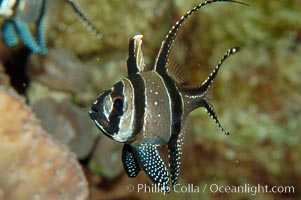
Banggai Cardinalfish. Once thought to be found at Banggai Island near Sulawesi, Indonesia, it has recently been found at Lembeh Strait and elsewhere. The male incubates the egg mass in his mouth, then shelters a brood of 10-15 babies in his mouth after they hatch, the only fish known to exhibit this behaviour. Unfortunately, the aquarium trade is threatening the survival of this species in the wild.
Species: Banggai cardinalfish, Pterapogon kauderni
Image ID: 09232
Species: Banggai cardinalfish, Pterapogon kauderni
Image ID: 09232

Banggai Cardinalfish. Once thought to be found at Banggai Island near Sulawesi, Indonesia, it has recently been found at Lembeh Strait and elsewhere. The male incubates the egg mass in his mouth, then shelters a brood of 10-15 babies in his mouth after they hatch, the only fish known to exhibit this behaviour. Unfortunately, the aquarium trade is threatening the survival of this species in the wild.
Species: Banggai cardinalfish, Pterapogon kauderni
Image ID: 09462
Species: Banggai cardinalfish, Pterapogon kauderni
Image ID: 09462

Pot-bellied seahorse, male, carrying eggs. The developing embryos are nourished by individual yolk sacs, and oxygen is supplied through a placenta-like attachment to the male. Two to six weeks after fertilization, the male gives birth. The babies must then fend for themselves, and few survive to adulthood.
Species: Pot-bellied seahorse, Hippocampus abdominalis
Image ID: 11895
Species: Pot-bellied seahorse, Hippocampus abdominalis
Image ID: 11895

Pot-bellied seahorse, male, carrying eggs. The developing embryos are nourished by individual yolk sacs, and oxygen is supplied through a placenta-like attachment to the male. Two to six weeks after fertilization, the male gives birth. The babies must then fend for themselves, and few survive to adulthood.
Species: Pot-bellied seahorse, Hippocampus abdominalis
Image ID: 11896
Species: Pot-bellied seahorse, Hippocampus abdominalis
Image ID: 11896

Pot-bellied seahorse, male, carrying eggs. The developing embryos are nourished by individual yolk sacs, and oxygen is supplied through a placenta-like attachment to the male. Two to six weeks after fertilization, the male gives birth. The babies must then fend for themselves, and few survive to adulthood.
Species: Pot-bellied seahorse, Hippocampus abdominalis
Image ID: 11029
Species: Pot-bellied seahorse, Hippocampus abdominalis
Image ID: 11029